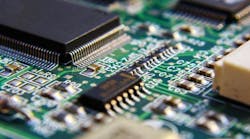Texas Instruments slashed the standby current of its latest linear dropout regulator (LDO), aiming to more than double the battery life of compact devices ranging from portable medical and consumer wearables to video doorbells and security cameras. The new chip, the TPS7A02, sips only 25 nA of standby current—one-tenth of competing products—the Dallas, Texas-based supplier said.
Texas Instruments said the LDO uses such a small amount of quiescent current that it can double a device's battery life before it needs to be recharged. Quiescent current (IQ) is burned by a system in standby mode with light or no load. Many portable medical and consumer wearables spend most of the time in standby or light load conditions. Even though the device's display may be shut off, the sensors inside it are still counting your steps or measuring your pulse.
The TPS7A02 also consumes a small amount of current when a system is turned off but the battery stays connected. With a so-called shutdown current of 3 nA, LDO delivers up to 5 times longer shelf life in small-battery systems. The chip also features faster wake-up times and quicker transient responses, Texas Instruments said. It can start supplying a stable voltage in less than 5 μs for 1-to-50-mA load transients—half the time of rival LDOs, the company claims.
The ability to respond quickly to rapidly changing loads is another key feature of the TPS7A02. The chip can switch from a current-saving, low-load state to a high-load, fast-transient state without the need for any additional components, reducing costs and the solution's footprint. The chip is also designed to reduce variations in output voltage, which helps medical devices and other wearables to more accurately measure things like heartrate, Texas Instruments said.
The TPS7A02 is a pin-to-pin, drop-in replacement for current linear regulators. Texas Instruments is selling pre-production samples in a small-outline no-lead (X2SON) packages measuring 1-mm by 1-mm. It is also crammed in a 2.9-mm by 1.6-mm small outline transistor (SOT-23) package, which will start shipping before the end of 2019. The company plans to add a die-size ball grid array (DSBGA) package measuring 0.65-mm by 0.65-mm by early 2020.
Pricing starts at $0.49 in 1,000-unit orders, the company said.
